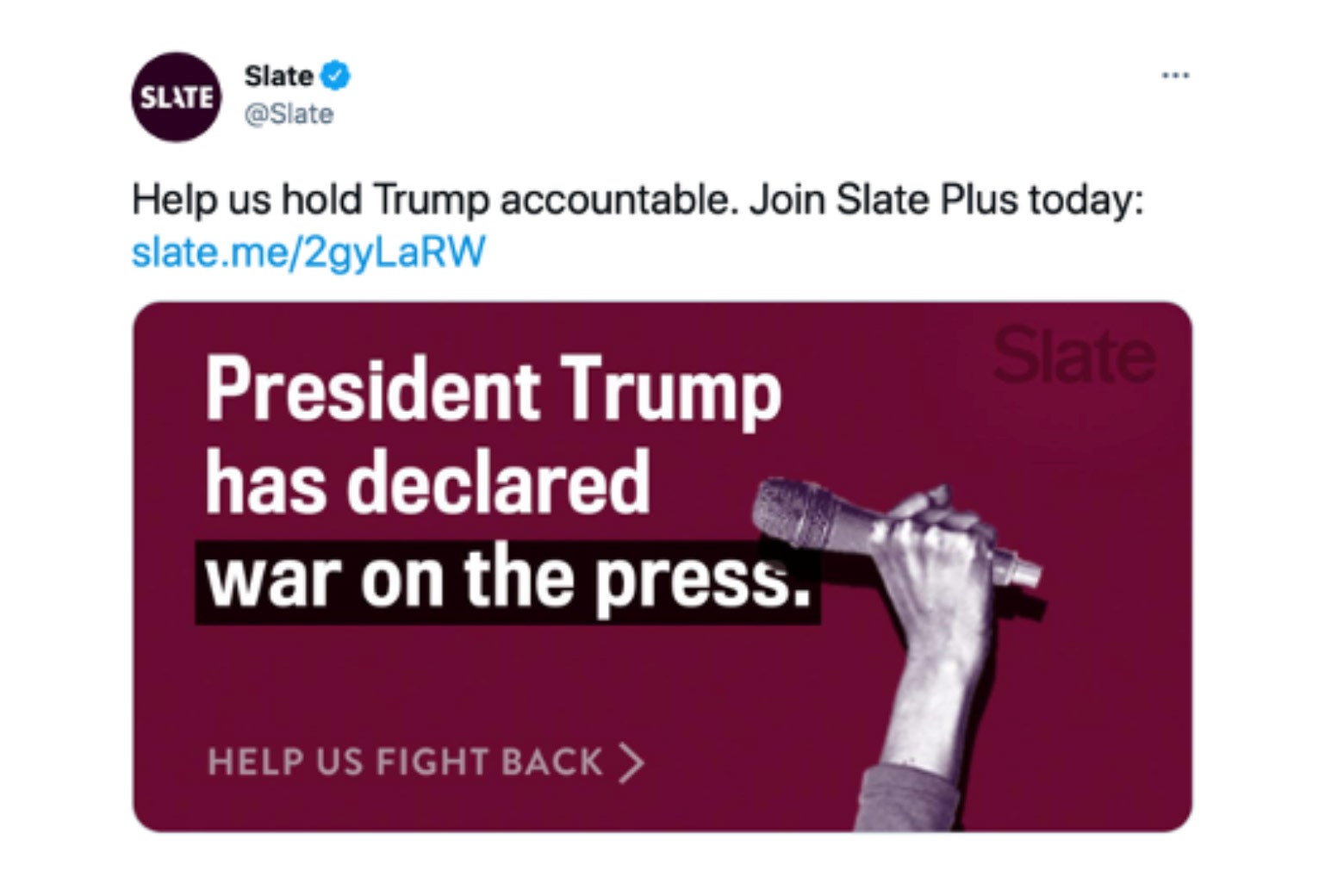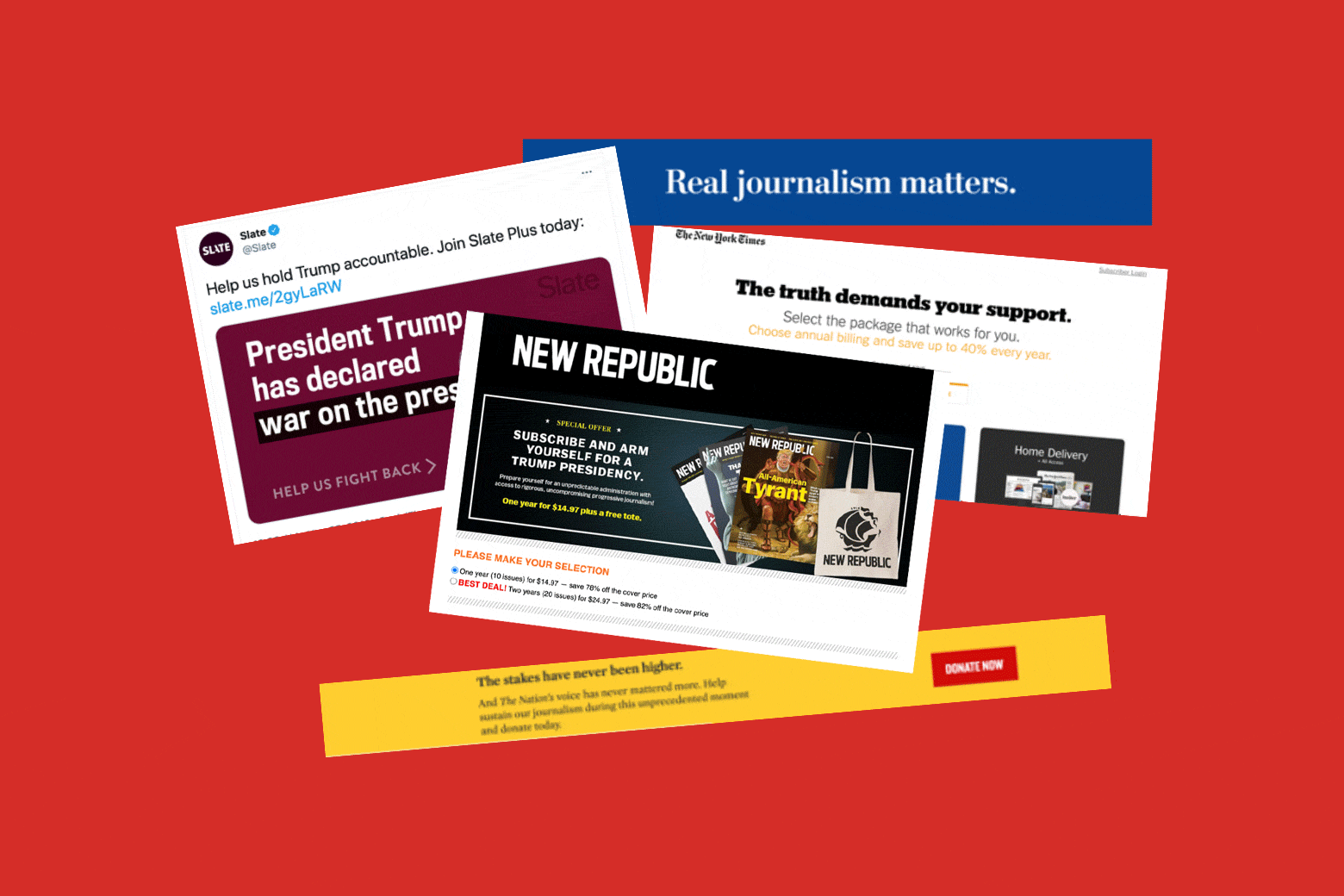This is part of Trump Slump, a series of stories checking in on how things are going now for the people and products that were riding high during the last administration.
Donald Trump aimed to drive public distrust in the media. He did a fair bit of that throughout his presidency, but he also sent the public to the media in droves. National newspapers and magazines capitalized on Trump’s rhetoric and used it to entice and secure subscribers. Subscriptions to major newspapers were on a slow rise before Trump got into office, but they noticeably spiked in the wake of the 2016 election. And Trump’s rhetoric certainly affected the way media outlets made their pitches to readers, too.
The phenomenon of papers covering the Trump presidency and attracting more subscribers as a result is so prevalent that it’s been colloquially named the Trump Bump. “The Trump Bump was real,” Rick Edmonds, a media business researcher and analyst at the Poynter Institute, told Slate. “And it was clearly a factor, though not the only factor, in the New York Times and Washington Post’s terrific growth in paid digital subscriptions.” Ken Doctor, a news analyst who runs Newsonomics, noted advertising that used targeted language about fact-checking Trump worked to build subscriber numbers. The message many publications have leaned on, Doctor said, is “trust us and we’ll keep you informed, and be a counterweight against misinformation and disinformation.”

When the president pounded the “fake news” drum, media outlets advertised their ability to bring readers the truth. I used the Wayback Machine to bring up some of the extremely specific language they used. Shortly after Trump assumed the presidency, for example, the Washington Post adopted the slogan “Democracy Dies in Darkness” (I didn’t need to spelunk the internet to remember that one), but it also advertised “Real Journalism Matters” on its subscriber page. The Intercept asked for support in 2017 by writing on its donation page, “Our reporters go to extraordinary lengths to bring you the evidence you need to challenge official lies and the distorted media narratives they produce.” In 2019, the New York Times asked readers to subscribe in order to “Help Our Journalists Get to the Truth.”

As Trump declared war on the press, the New Republic told readers, in 2017, to “subscribe and arm yourself for a Trump presidency.” The Intercept drew donors by saying “protecting the freedom of the press has never been more important.” The Nation appealed to readers, in 2018, with an Obama quote on their subscriber page—the former president had endorsed the magazine as “a crucible of ideas.” Slate advertised Slate Plus to readers as a way to specifically, for example, “hold Trump accountable” in 2016 and “support Michelle Goldberg’s coverage of the Trump administration” in 2017.

And readers responded by clicking that subscribe button. The New York Times told Slate that they closed out 2017 with 3.4 million subscribers. By the end of 2020, and the end of Trump’s term, they had 7.5 million. Subscribers to the Washington Post tripled over the course of Trump’s presidency. The Wall Street Journal attracted about a million subscribers between January 2017 and March 2020. The Atlantic told Slate that it gained 400,000 new subscribers in 2020 alone.
When Trump left office, many pundits hailed the incoming Biden presidency as a “return to normalcy.” Yet for news, Edmonds—the media business analyst—says, this has been “a return to, sort of, boring.” The constant vibration of news alerts has quieted. And the industry has too. As the Nieman Journalism Lab wrote in its 2021 journalism industry predictions: “The ‘Trump Bump’ is already waning. The question now is: How many of those readers will remain loyal and enter their credit card info again once the sense of alarm that moved them in the first place dissipates?”
Not as many, it seems. On Wednesday, the New York Times reported the smallest subscriber increase in over a year. The paper gained only 301,000 new subscribers in the first three months of 2021. The Washington Post revealed that their traffic “plummeted” in February of 2021. CNN lost 45 percent of its viewers across February and March, though Don Lemon of CNN told the New York Times that he would rather have fewer viewers than have to deal with Trump. But Trump was good for the press business, and while Cameron Barr, the interim executive editor of the Washington Post, has issued the requisite statements (“We intend to cover this president as aggressively as we covered his predecessors”), it’s hard not to feel that the news of the day has gotten a bit flatter. But if Slate’s latest campaign is any indication, there’s still plenty to worry about.

